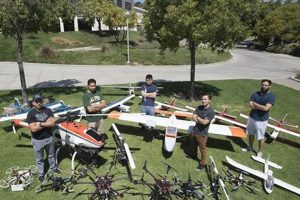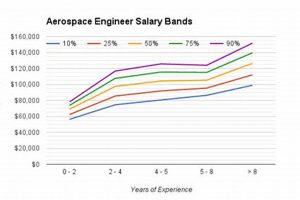Compensation for professionals designing, developing, and testing aircraft, spacecraft, and related systems generally reflects education, experience, specialization, and geographic location. For instance, an entry-level engineer focusing on structural analysis in a rural area will likely receive a different salary than a seasoned professional managing propulsion systems in a major metropolitan area.
Understanding typical earnings is crucial for career planning, negotiation, and assessing the value of this specialized skillset. Such figures provide a benchmark against which individual salaries can be evaluated, considering factors such as performance, company size, and industry sector. Historical data illustrates how economic trends and technological advancements influence the value placed on this expertise.
The following sections will delve into the factors that contribute to variations in this compensation, explore relevant data sources, and offer insights into career advancement opportunities within the field.
Guidance Regarding Remuneration for Aerospace Engineers
The subsequent recommendations are intended to provide insights for navigating salary expectations and negotiations within the aerospace engineering profession. Understanding these points can contribute to informed career decisions.
Tip 1: Research Regional Cost of Living: Salary offers should be evaluated in the context of the local cost of living. A higher figure in one geographic area might not equate to greater financial well-being if the expenses are proportionally higher.
Tip 2: Consider Experience Level: Entry-level positions will naturally command lower salaries than those requiring substantial experience. Benchmark offers against industry standards for comparable experience brackets.
Tip 3: Highlight Specialized Skills: Possessing expertise in high-demand areas, such as autonomous systems or advanced materials, can justify a request for higher remuneration. Clearly articulate these skills during negotiations.
Tip 4: Factor in Education and Certifications: Advanced degrees and relevant certifications can significantly impact earning potential. Ensure these qualifications are emphasized during the application process and salary discussions.
Tip 5: Negotiate Benefits Packages: Compensation extends beyond base salary. Consider the value of benefits such as health insurance, retirement plans, stock options, and paid time off when evaluating an offer.
Tip 6: Understand Company Size and Type: Large corporations may offer different salary structures compared to smaller firms or government agencies. Research typical compensation ranges for similar roles within different organizations.
Tip 7: Monitor Industry Trends: Stay informed about emerging technologies and market shifts within the aerospace sector. Skills in areas with high growth potential will command a premium.
In summary, understanding regional economic factors, demonstrating specialized skills, and carefully evaluating the entire compensation package are crucial steps in securing fair remuneration within this field.
The article will now proceed to examine data sources and career progression within aerospace engineering.
1. Education Level
Educational attainment significantly impacts compensation within the field of aerospace engineering. Higher levels of education often correlate with increased responsibilities, specialized knowledge, and enhanced problem-solving capabilities, thereby influencing earning potential.
- Bachelor’s Degree Entry Point
A bachelor’s degree in aerospace engineering serves as the foundational entry point for most positions. Graduates with this degree typically qualify for entry-level roles involving design, testing, and analysis. While providing a necessary foundation, a bachelor’s degree generally results in a lower starting salary compared to those with advanced degrees due to limited specialized knowledge and experience.
- Master’s Degree Specialization
Pursuing a master’s degree allows for specialization within a specific area of aerospace engineering, such as aerodynamics, propulsion, or structural mechanics. This advanced knowledge enables graduates to tackle more complex projects and assume leadership roles. The enhanced expertise and specialization typically translate into higher earning potential compared to those with only a bachelor’s degree.
- Doctoral Degree Research and Development
A doctoral degree focuses on research and development, preparing individuals for careers in academia, research institutions, or advanced engineering roles within industry. PhD graduates possess the expertise to conduct original research, develop innovative technologies, and lead complex projects. This high level of expertise commands a premium in the job market, resulting in significantly higher average compensation.
- Continuing Education and Certifications
Beyond formal degrees, continuing education courses and professional certifications, such as those offered by professional engineering societies, can contribute to increased earnings. These credentials demonstrate a commitment to professional development and enhance expertise in specific areas, making individuals more valuable to employers. While not equivalent to a graduate degree, these qualifications can positively impact compensation.
In summary, the level of formal education attained directly correlates with earning potential within the field. Advanced degrees, particularly those involving specialized knowledge and research capabilities, command higher salaries due to the increased value and expertise they bring to complex engineering challenges. Furthermore, continuous learning and professional certifications support career advancement and earnings growth throughout an engineer’s career.
2. Experience Years
Years of accumulated professional experience exert a direct and quantifiable influence on the compensation earned by aerospace engineers. Entry-level positions, typically requiring minimal prior experience, command lower salaries due to the need for on-the-job training and supervision. As engineers accumulate experience, their problem-solving skills, technical proficiency, and project management capabilities increase, leading to greater contributions and responsibilities within their organizations. Consequently, salaries tend to increase commensurately with experience.
The progression of compensation with experience can be observed across various levels of aerospace engineering roles. For instance, an engineer with five years of experience might transition from performing routine analyses to leading small project teams, resulting in a salary increase that reflects their enhanced responsibilities and expertise. Similarly, an engineer with ten or more years of experience may move into management roles, overseeing larger projects and personnel, which further elevates their earning potential. This correlation is further reinforced by the demand for experienced professionals who can effectively mentor junior engineers and contribute to strategic decision-making within engineering departments. Example: An aerospace engineer with 15 years experience specialized in fluid dynamics and CFD (computational fluid dynamics), can get a high demand since his knowledge and experiences. The practical significance of understanding this relationship lies in its implications for career planning and salary negotiation. Engineers can leverage their experience to demonstrate their value to potential employers and negotiate for salaries that accurately reflect their contributions.
In summary, experience years serve as a primary determinant of compensation within aerospace engineering. The progressive accumulation of skills, knowledge, and responsibilities over time leads to increased value for employers and, consequently, higher earning potential. While other factors such as education, specialization, and geographic location also play a role, experience remains a critical factor in shaping the financial trajectory of an aerospace engineer’s career.
3. Geographic Location
Geographic location exerts a substantial influence on the prevailing compensation levels within the aerospace engineering profession. This correlation arises primarily from variations in the cost of living, the concentration of aerospace industries, and regional economic factors. Areas with higher costs of living, such as major metropolitan centers and regions with robust aerospace sectors, typically exhibit elevated salary scales to offset increased expenses for housing, transportation, and other essential goods and services.
For instance, aerospace engineers employed in California, particularly in the Silicon Valley or Southern California regions, often command higher salaries compared to their counterparts in states with lower costs of living and fewer aerospace companies. Similarly, regions such as Washington State, home to major aircraft manufacturers, may offer competitive compensation packages to attract and retain talent within this specialized field. Conversely, areas with fewer aerospace employers and lower costs of living may offer less competitive salaries, even for engineers with comparable experience and qualifications. The implications of this geographic disparity are significant for both employers and employees within the aerospace engineering sector. Companies seeking to minimize labor costs may choose to locate facilities in areas with lower compensation levels, while engineers seeking to maximize their earning potential may prioritize employment opportunities in regions with higher industry concentrations and more competitive salaries.
In summary, geographic location represents a critical determinant of compensation in aerospace engineering, reflecting the interplay of cost-of-living considerations, industry concentrations, and regional economic factors. Awareness of these geographic disparities is essential for both employers and engineers to make informed decisions regarding hiring, employment, and career planning within this highly specialized field.
4. Industry Sector
The specific industry sector in which an aerospace engineer is employed exerts a considerable influence on their earning potential. This stems from variations in funding levels, project complexity, profit margins, and demand for specialized skills across different sectors.
- Commercial Aviation
This sector encompasses the design, manufacturing, and maintenance of commercial aircraft for passenger and cargo transport. Compensation in this sector is often stable, driven by the continuous demand for air travel and aircraft upgrades. However, profit margins can be sensitive to economic cycles and fuel prices, which may indirectly influence salary adjustments and bonuses.
- Defense and Government Contracting
This sector involves developing military aircraft, missile systems, and space-based technologies for defense agencies and government organizations. Salaries are typically competitive, supported by government funding and long-term contracts. Specialized expertise in areas such as stealth technology, cybersecurity, and secure communications can command a premium in this sector.
- Space Exploration
This sector focuses on designing spacecraft, satellites, and launch vehicles for space exploration and research. Funding is often driven by government agencies, such as NASA, and private space companies. Compensation levels can vary depending on the size and financial stability of the organization, with private companies sometimes offering higher equity-based incentives in addition to base salaries.
- Research and Development
This sector involves conducting research and developing innovative technologies for future aerospace applications. Opportunities can be found in universities, government laboratories, and private research institutions. Salaries may be lower compared to other sectors, but this is often offset by the opportunity to work on cutting-edge research and contribute to advancements in the field.
The compensation for professionals in aerospace engineering will also vary depending on company sizes, ranging from startups and medium scale industry to giant multinational corporation. It is important to note that certain industrial sectors also have specific location and market condition that needs attention in salary negotiation.
5. Specialized Skills
The “average pay of an aerospace engineer” is significantly influenced by the possession of specialized skills. A direct correlation exists between the depth and market demand for particular skill sets and the remuneration commanded by professionals in this field. This is due, in part, to the increasing complexity of aerospace projects, which necessitates expertise beyond general engineering principles.
For example, engineers proficient in computational fluid dynamics (CFD) or finite element analysis (FEA) skills essential for designing efficient and structurally sound aircraft often receive higher compensation due to the criticality of these tools in modern aerospace engineering. Similarly, expertise in areas like avionics, propulsion systems, or autonomous flight control systems can command a premium due to the specialized knowledge required. Employers recognize the value of engineers who can contribute directly to these key areas, leading to increased compensation packages. The practical significance of this lies in the ability of aerospace engineers to increase their earning potential by strategically developing specialized skills that are in high demand within the industry.
Conversely, a lack of specialization can limit career advancement and earning potential. While a general understanding of aerospace engineering principles is important, it is the mastery of specific skills that differentiates candidates and allows them to contribute to projects at a higher level. The challenge for aspiring aerospace engineers is to identify and develop these specialized skills, often through advanced education, targeted training, and hands-on experience. By doing so, they can significantly impact their future compensation and career trajectory.
6. Company Size
Company size significantly influences compensation levels for aerospace engineers. Large corporations, characterized by substantial revenues, complex organizational structures, and extensive project portfolios, typically offer more competitive salary packages and benefits compared to smaller firms. This discrepancy stems from several factors. Larger companies often possess greater financial resources, enabling them to attract and retain highly skilled engineers by offering superior compensation. Furthermore, they frequently manage larger, more complex projects that necessitate specialized expertise, thereby justifying higher salaries for qualified personnel. Real-world examples include multinational aerospace conglomerates, which provide comprehensive benefit packages and higher salaries to engineers involved in advanced research, development, and manufacturing activities. In contrast, smaller aerospace firms or startups may operate with limited resources and project scopes, resulting in comparatively lower compensation levels.
The impact of company size extends beyond base salary. Larger companies often offer more comprehensive benefits packages, including health insurance, retirement plans, stock options, and professional development opportunities. These benefits collectively contribute to the overall compensation value, making employment with larger organizations financially advantageous. However, smaller companies may offer unique benefits, such as greater autonomy, faster career progression, and a more collaborative work environment. While the base salary may be lower, these factors can contribute to increased job satisfaction and long-term career growth. For example, an aerospace engineer might choose to work for a small, innovative startup, accepting a lower initial salary in exchange for the opportunity to gain experience in a diverse range of engineering disciplines and potentially acquire equity in the company.
Understanding the connection between company size and compensation is crucial for career planning and salary negotiation. Aerospace engineers should consider their career goals, financial priorities, and preferred work environment when evaluating employment opportunities. While larger companies often offer higher salaries and benefits, smaller firms may provide valuable experience and unique opportunities for growth. Ultimately, the optimal choice depends on individual preferences and long-term career aspirations. Navigating this aspect requires careful consideration of personal circumstances and a comprehensive understanding of the industry landscape, aligning individual objectives with the specific attributes of potential employers.
Frequently Asked Questions Regarding Aerospace Engineer Compensation
The following section addresses common inquiries related to typical earnings for professionals in this field, providing clarity on various aspects of compensation determination.
Question 1: What is the typical starting salary for an aerospace engineer with a bachelor’s degree?
Entry-level salaries vary based on location, company size, and specific job responsibilities, but generally fall within a defined range. Industry data suggests a typical starting point for graduates with a bachelor’s degree in aerospace engineering.
Question 2: How does a master’s degree affect the average pay of an aerospace engineer?
Possessing a master’s degree typically leads to higher earning potential compared to a bachelor’s degree. The advanced knowledge and specialization gained through graduate studies are often reflected in increased compensation.
Question 3: What regions in the United States offer the highest compensation for aerospace engineers?
Certain geographic areas, characterized by a high concentration of aerospace companies and a higher cost of living, generally offer more competitive salaries. Specific states or metropolitan areas tend to lead in compensation levels.
Question 4: Does working for a large aerospace corporation result in higher pay compared to a smaller company?
Larger corporations often provide more comprehensive benefits packages and higher salaries due to greater financial resources. However, smaller companies may offer other advantages, such as faster career advancement.
Question 5: Which specialized skills or areas of expertise are most valued in the aerospace engineering job market?
Expertise in high-demand areas, such as autonomous systems, advanced materials, or cybersecurity, can command a premium in the job market. Specific skills that contribute to critical project needs are highly valued.
Question 6: How frequently do aerospace engineers typically receive salary increases throughout their careers?
Salary increases are often tied to performance evaluations, promotions, and overall economic conditions. The frequency and magnitude of increases vary depending on the company and individual performance.
In conclusion, understanding the factors that influence typical earnings is essential for career planning and negotiation within the aerospace engineering profession. A comprehensive approach considering education, experience, location, and specialized skills will contribute to informed decision-making.
The subsequent section will provide a summary of the key findings discussed throughout this analysis.
Average Pay of an Aerospace Engineer
The preceding analysis has explored the multifaceted influences on the “average pay of an aerospace engineer.” Education level, years of experience, geographic location, industry sector, specialized skills, and company size are all significant determinants. A nuanced understanding of these factors is crucial for both employers seeking to attract talent and engineers navigating their career paths.
Given the dynamic nature of the aerospace industry and the ongoing evolution of technological demands, professionals are encouraged to proactively cultivate in-demand skills and maintain awareness of market trends. Continuous professional development and strategic career planning remain paramount for maximizing earning potential in this competitive field. The exploration of compensation is a continuous process, requiring adaptation to market shifts and a commitment to personal growth.




![Best Berkeley Aerospace Engineering Programs [Guide] Safem Fabrication - Precision Engineering & Custom Manufacturing Solutions Best Berkeley Aerospace Engineering Programs [Guide] | Safem Fabrication - Precision Engineering & Custom Manufacturing Solutions](https://mixaerospace.com/wp-content/uploads/2025/06/th-4412-300x200.jpg)


